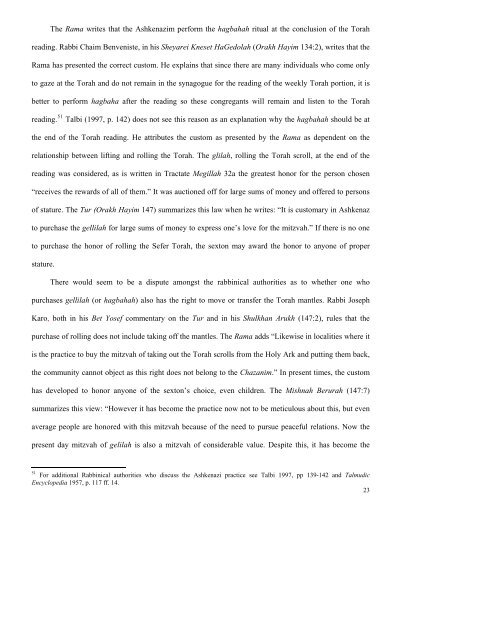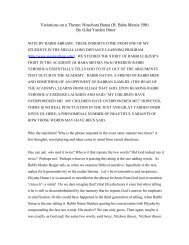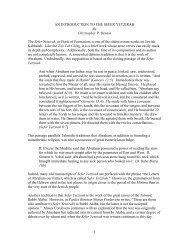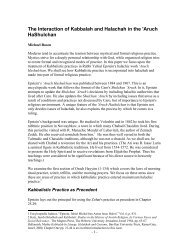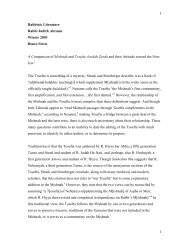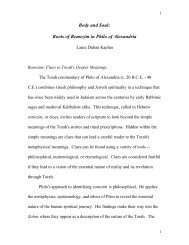The Symbolic Representation of the Sefer Torah - Maqom
The Symbolic Representation of the Sefer Torah - Maqom
The Symbolic Representation of the Sefer Torah - Maqom
You also want an ePaper? Increase the reach of your titles
YUMPU automatically turns print PDFs into web optimized ePapers that Google loves.
<strong>The</strong> Rama writes that <strong>the</strong> Ashkenazim perform <strong>the</strong> hagbahah ritual at <strong>the</strong> conclusion <strong>of</strong> <strong>the</strong> <strong>Torah</strong>reading. Rabbi Chaim Benveniste, in his Sheyarei Kneset HaGedolah (Orakh Hayim 134:2), writes that <strong>the</strong>Rama has presented <strong>the</strong> correct custom. He explains that since <strong>the</strong>re are many individuals who come onlyto gaze at <strong>the</strong> <strong>Torah</strong> and do not remain in <strong>the</strong> synagogue for <strong>the</strong> reading <strong>of</strong> <strong>the</strong> weekly <strong>Torah</strong> portion, it isbetter to perform hagbaha after <strong>the</strong> reading so <strong>the</strong>se congregants will remain and listen to <strong>the</strong> <strong>Torah</strong>reading. 51 Talbi (1997, p. 142) does not see this reason as an explanation why <strong>the</strong> hagbahah should be at<strong>the</strong> end <strong>of</strong> <strong>the</strong> <strong>Torah</strong> reading. He attributes <strong>the</strong> custom as presented by <strong>the</strong> Rama as dependent on <strong>the</strong>relationship between lifting and rolling <strong>the</strong> <strong>Torah</strong>. <strong>The</strong> glilah, rolling <strong>the</strong> <strong>Torah</strong> scroll, at <strong>the</strong> end <strong>of</strong> <strong>the</strong>reading was considered, as is written in Tractate Megillah 32a <strong>the</strong> greatest honor for <strong>the</strong> person chosen“receives <strong>the</strong> rewards <strong>of</strong> all <strong>of</strong> <strong>the</strong>m.” It was auctioned <strong>of</strong>f for large sums <strong>of</strong> money and <strong>of</strong>fered to persons<strong>of</strong> stature. <strong>The</strong> Tur (Orakh Hayim 147) summarizes this law when he writes: “It is customary in Ashkenazto purchase <strong>the</strong> gellilah for large sums <strong>of</strong> money to express one’s love for <strong>the</strong> mitzvah.” If <strong>the</strong>re is no oneto purchase <strong>the</strong> honor <strong>of</strong> rolling <strong>the</strong> <strong>Sefer</strong> <strong>Torah</strong>, <strong>the</strong> sexton may award <strong>the</strong> honor to anyone <strong>of</strong> properstature.<strong>The</strong>re would seem to be a dispute amongst <strong>the</strong> rabbinical authorities as to whe<strong>the</strong>r one whopurchases gellilah (or hagbahah) also has <strong>the</strong> right to move or transfer <strong>the</strong> <strong>Torah</strong> mantles. Rabbi JosephKaro, both in his Bet Yosef commentary on <strong>the</strong> Tur and in his Shulkhan Arukh (147:2), rules that <strong>the</strong>purchase <strong>of</strong> rolling does not include taking <strong>of</strong>f <strong>the</strong> mantles. <strong>The</strong> Rama adds “Likewise in localities where itis <strong>the</strong> practice to buy <strong>the</strong> mitzvah <strong>of</strong> taking out <strong>the</strong> <strong>Torah</strong> scrolls from <strong>the</strong> Holy Ark and putting <strong>the</strong>m back,<strong>the</strong> community cannot object as this right does not belong to <strong>the</strong> Chazanim.” In present times, <strong>the</strong> customhas developed to honor anyone <strong>of</strong> <strong>the</strong> sexton’s choice, even children. <strong>The</strong> Mishnah Berurah (147:7)summarizes this view: “However it has become <strong>the</strong> practice now not to be meticulous about this, but evenaverage people are honored with this mitzvah because <strong>of</strong> <strong>the</strong> need to pursue peaceful relations. Now <strong>the</strong>present day mitzvah <strong>of</strong> gelilah is also a mitzvah <strong>of</strong> considerable value. Despite this, it has become <strong>the</strong>51 For additional Rabbinical authorities who discuss <strong>the</strong> Ashkenazi practice see Talbi 1997, pp 139-142 and TalmudicEncyclopedia 1957, p. 117 ff. 14.23


